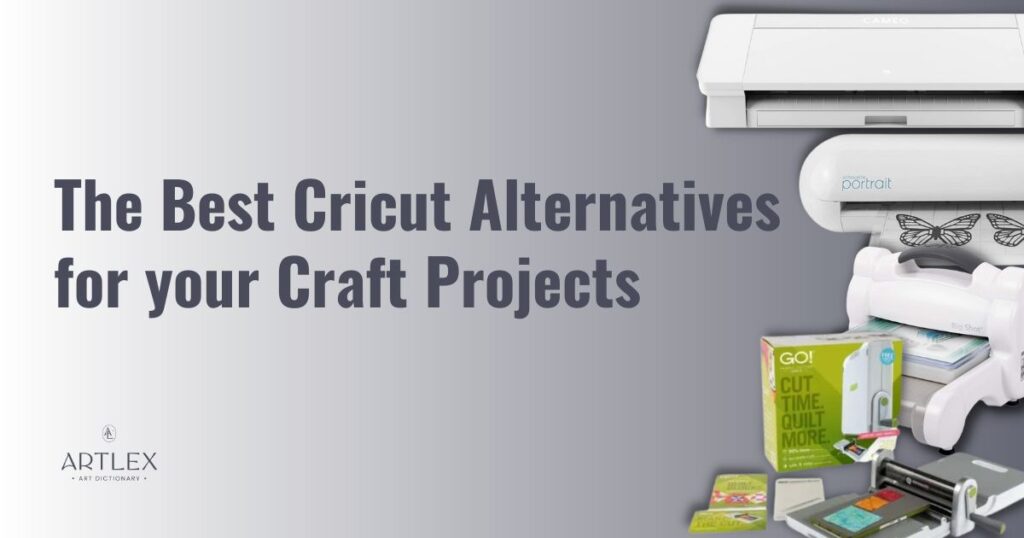
Electronic cutting machines have a relatively short history compared to other types of tools and equipment, in contrast to die-cutting machines that operate mechanically and need templates or dies to work, these machines opened a new world of possibilities to the crafting industry.
Although professional plotters and large-scale cutting machines were great for mass production, personal cutting machines like the Cricut were the perfect solution for the hobbyist and home crafters due to their small size, ability to cut several types of materials, and due to the fact that these machines could be used by anyone without needing specialized knowledge or skills.
The Cricut was designed to be a portable, easy-to-use, and affordable machine compared to the large industry cutting machine prices, However, as the market for electronic cutting machines has grown, so too has the range of affordable options available from other companies.
While the Cricut remains a popular choice, there are other more affordable alternatives that offer the same if not better features and quality.
In this article, we will examine some of the best Cricut alternatives on the market, taking into account factors such as affordability, ease of use, versatility, and performance.
Types of Cutting Machines
Before jumping to the list of Cricut alternatives, let’s learn a bit about the different types of cutting machines that exist on the market.
Manual Cutting Machines
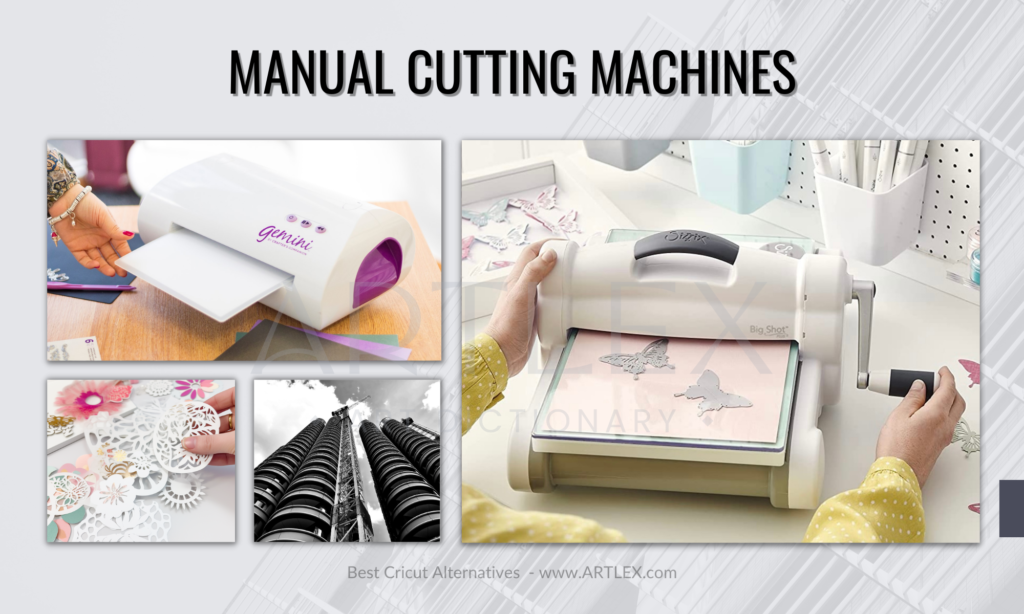
Within the cutting machines that are closest to Cricut, we can find the Die Cutting machines. These machines use metal dies to cut shape sand designs out of different materials like paper, fabric, cardstock, etc.
In simpler terms, they are like giant cookie cutters but instead of cutting dough, they cut through paper, leather, etc.
These machines work using pressure and are very easy to use, you simply put the material you want to cut between the cutting pad and the metal die, and roll them through the machine which applies pressure to the die, cutting the material into the die’s shape.
These machines are very popular among scrapbooking communities and hobbyists since they’re very affordable and long-lasting. Although they’re not as versatile as electronic cutting machines, with the right dies, they cut a wide variety of materials quickly and efficiently.
Electronic Cutting Machines
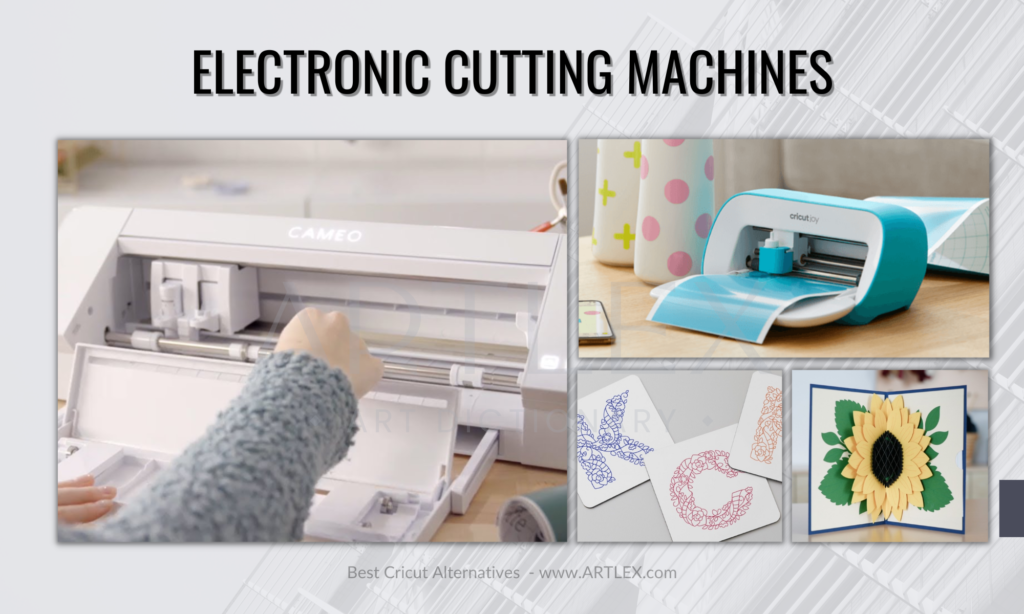
The Cricut cutting machines fall directly into the electronic cutting machines category, they use computer-controlled carriages that hold housings for blades and other tools.
Although these machines are used mainly for cutting, they come with an interchangeable adapter for different types of tools, like blades, markers, and embossers that expand the capabilities of the machine beyond just cutting. In addition to the interchangeable housing system, modern cutting machines also come with their own software that allows users to design and customize their projects.
With this software which is subscription-based in most cases, users can also have access to a library of pre-made designs and patterns that can be used directly or customized to fit their specific needs. Furthermore, some cutting machines offer Bluetooth connectivity and apps that support both desktop and mobile interfaces, for added convenience and flexibility.
Laser cutting machines
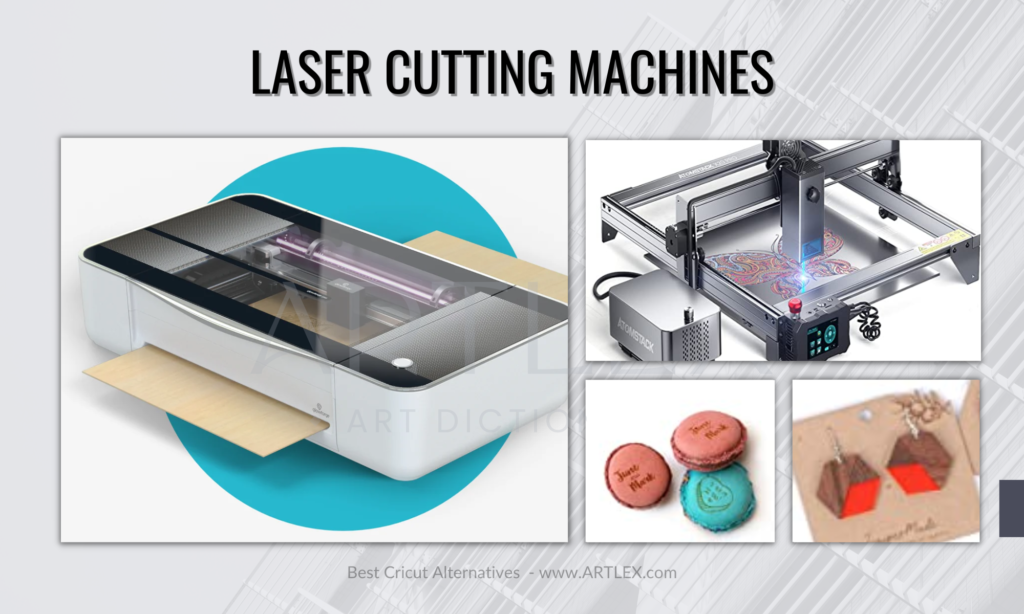
Laser for cutting is a relatively modern technology that has become very popular in the past few years due to its precision, speed, and versatility.
Laser cutting machines use a high-powered laser beam to cut and engrave in different materials. In contrast to Cricut machines, they are typically used for industrial purposes and are known for their high precision and ability to cut a wide range of materials, including metal, wood, and glass.
Cricut machines, on the other hand, are designed for hobbyists and crafters and are mainly used for cutting materials such as paper, vinyl, and fabric which are hard to cut with a laser or need a specially optimized machine to do that.
While laser-cutting machines and Cricut machines may not necessarily be considered direct alternatives, they can be used for similar purposes; however, the cost and ease of use is a factor that needs to be thoroughly considered since budget laser-cutting machines need much more maintenance and after-care than an average cutting machine, and are also much more expensive.
Other cutting machines
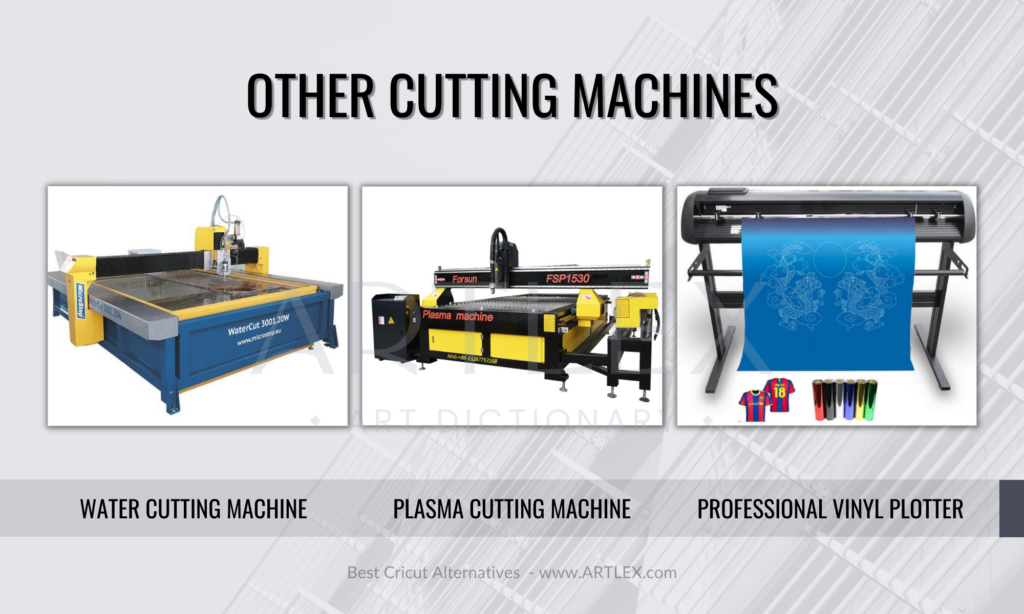
While there are other types of cutting machines available such as water cutting machines, plasma cutting machines, vinyl cutting machines, and CNC cutting machines, they are not typically used for personal crafting purposes and are not relevant to the discussion of portable, personal cutting machines like the Cricut. Therefore, we will not be discussing them in this article.
What to look for in a cutting machine?
Type of Machine
Although a manual cutting device operates quite differently from an electronic one, some crafters may find that a manual device suits their needs better than an electronic one.
While there are several types of cutting machines available, the ones that most closely resemble the Cricut are small-scale manual and electronic cutting machines. Sometimes, opting for a manual cutting machine is a better alternative due to the lower cost and smaller scale of projects.
Manual cutting machines are great for scrapbooking, cutting the same pattern in bulk, and small-scale projects. They are much more affordable, don’t require electricity, a computer, or a mobile device to operate, and have a different appeal and aesthetic compared to electronic ones. However, their downside is the limited cutting area, limited designs available, and limited range of materials compatible with the dies.
Dimensions and Cutting Size
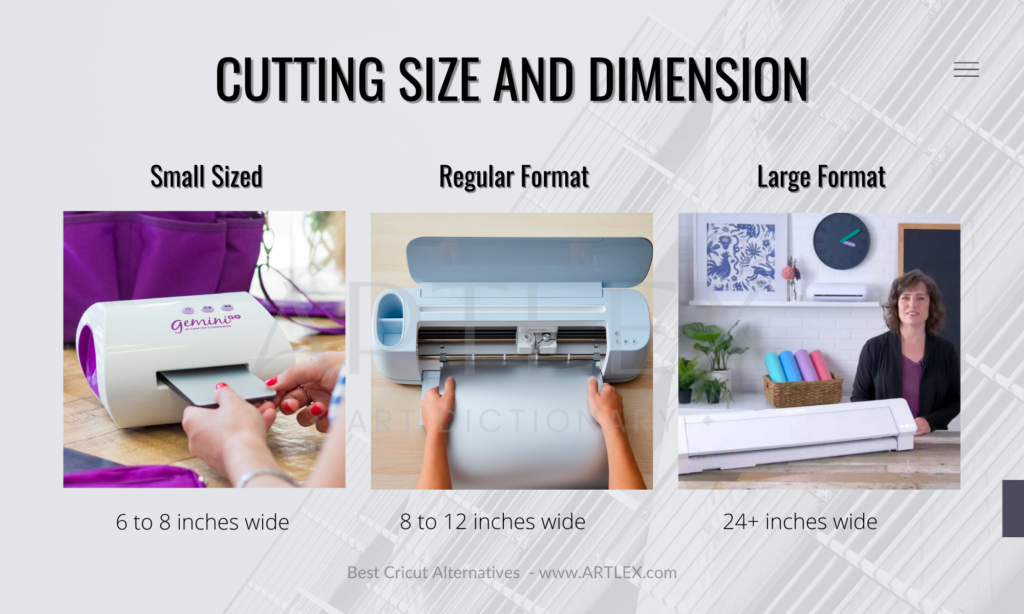
In terms of dimensions, a personal cutting machine is not particularly large or heavy. A Cricut Maker cutting machine, for example, is about the same size as a large but thin printer, and if we’re looking for alternatives to a Cricut, then we should aim for similar dimensions.
Cutting machines from Silhouette and Brother are about the same size as a Cricut, however, you must remember that you’d also need to accommodate space for the cutting mat, both in front and in the back, especially if you’re planning on printing larger designs.
However, if you have limited desk space and can’t accommodate a 22-inch machine, then opting for a smaller, more compact manual cutting machine may be a better option for you. Ultimately, the choice between manual and electronic cutting machines comes down to personal preference, space available, budget, and project needs.
On the other hand, if you want to go for a larger cutting machine such as the Silhouette Cameo 4 Pro, which is ideal for large-scale projects and is the last step before going industrial, then you will most likely need a dedicated space for the machine only.
Keep in mind that larger machines are heavier, bulkier, and require more power. Additionally, they often come with a higher price tag, so it’s important to ensure that the investment is worth it for your specific needs.
Compatible Materials and Cutting Force
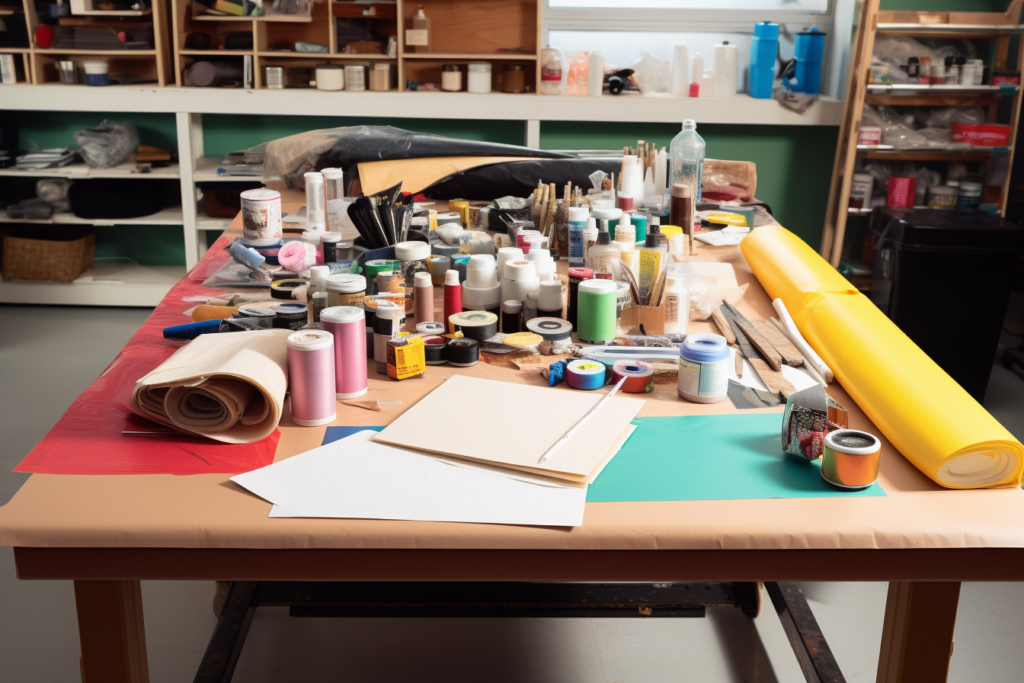
Another important factor to consider when choosing a cutting machine is its compatibility. Crafters don’t limit their creativity and often work with a wide range of materials, so it’s important to find a machine that can handle different types of materials with ease. Using a cutting machine for a single purpose or material would be a waste of resources, potential, and a hinder to creativity.
While the material compatibility is directly tied to the tool used (blade) and the cutting base support (mat), size and the cutting area are also important factors to consider along with the thickness and hardness of the materials that the machine can handle, as this can affect the precision and quality of the cuts.
Most cutting machines can handle the same range of materials as a Cricut, however, there are some cutting machines in the market made for specific uses, like the US Cutter MH, that only cuts vinyl, and the AccuQuilt GO! which is specially made for fabric.
Additionally, manual die-cutting machines can only handle a portion of all the materials a digital cutter can, but their range is still pretty wide, so before purchasing a cutting machine we suggest you check the list of compatible materials and cutting force.
Ease of Use
Cutting machines should be relatively easy to use right? Well, kinda.
In contrast to manual cutting machines where you only need to follow a couple of steps to start crafting, digital cutting machines need a computer to be registered and set up, a PC or mobile device to work, electricity, and the knowledge of how to use the software that comes with the machine.
Additionally, they also require you to know about the different blades and functions they offer, materials, compatible tools, and of course, calibration. getting a digital cutting machine offers much more benefits than a manual one, however, it also has a steeper learning curve that in some cases, might end up being the reason people give up on their craft.
Brother has the most user-friendly interface, allowing you to use the machine without the need for a computer or mobile device, followed by Cricut and Silhouette, however, it is not for everybody and must be thoroughly beforehand to see if it would fit your specific crafting needs.
Software and Connectivity
Most people, especially beginners think that cutting machines work just like printers; however, most of them fail to understand that printers have been on the market as home and personal use devices for longer than cutting machines, so computers and mobile devices are optimized for direct use.
Remember that, cutting machines use special file formats in order to do certain cuts, handle different materials, and create projects. Said files need formatting and processing that needs to be made in the cutting machine’s software.
Additionally, since most design software is licensed or not accessible to everyone, cutting machines’ software also has some basic design functions that will help you reach the full potential of your machine without being a professional designer.
Cricut Desing Space is the software included with your Cricut machine, other brands like Silhouette and Brother have their own software, however, they are not the same as Cricut’s and might have a bit of a learning curve or work completely differently.
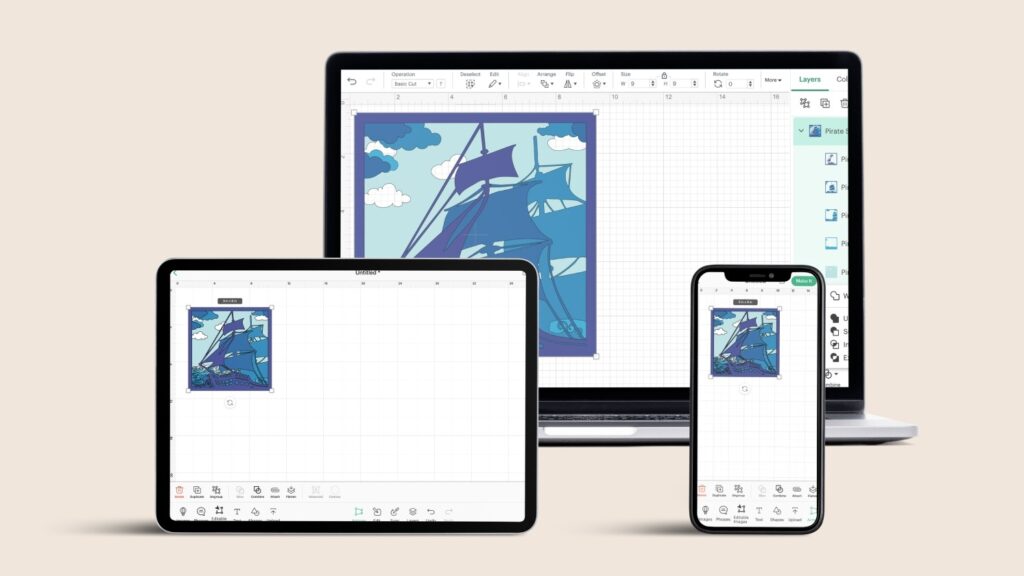
Silhouette Studio is the software offered with the Cameo Portrait, Cameo 4, Plus, and Pro. It’s free but has limited options that can be unlocked through an update system, with the business suite being the most expensive, yet the most versatile and powerful.
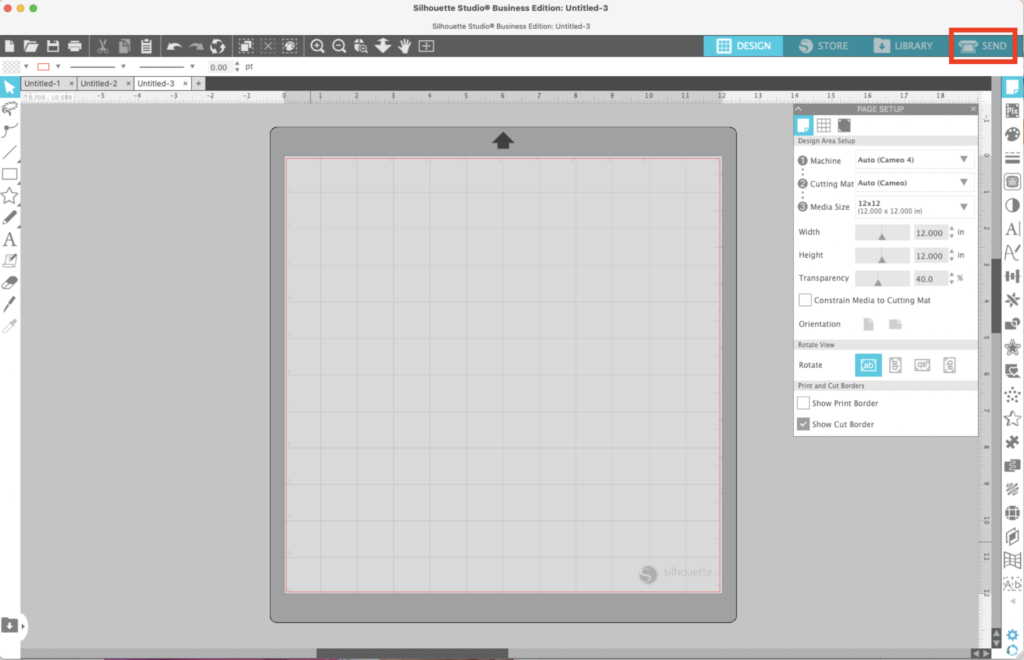
Brother Canvas Workspace is the software that can be used with most machines of the brand, including sewing machines, extending the possibilities for sewers and quilters since Brother’s software allows you to create and share designs through all their compatible machines. You can use the Desktop version as well as the App, and although it’s not as intuitive as Cricut’s it’s more beginner-friendly than Silohuette’s
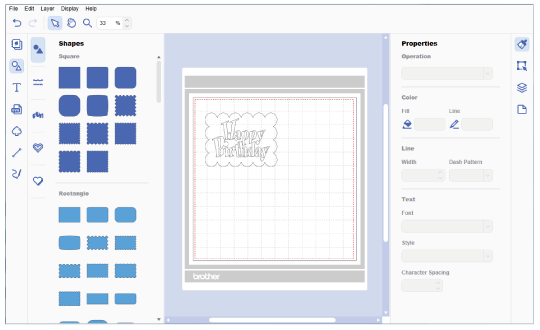
Connectivity is another factor to consider. Brother has the most user-friendly setup since it allows you to cut without the need for any computer or mobile device, however, it doesn’t offer Bluetooth connectivity. Silhouette machine shave reported issues with Bluetooth connectivity resulting in the waste of material and having to repeat the cutting process, but those reports have died down with the launch of the Cameo 4.
Price
A cutting machine’s price can be influenced by several factors, including its size, features, and material compatibility. A larger cutting machine with more advanced features and a wider range of compatible materials will typically be more expensive than a smaller, more basic machine. Additionally, it is very important to know that most machines will require additional tools or accessories that can add to the overall cost.
While some machines are usually sold as a “bundle including some basic tools, you might need to get other types of blades or mats for your specific craft, also, embossing and stapling tools are not included and present an additional cost.
If you opt for a manual cutting machine, the only additional costs you’ll have to consider are the dies. However, it’s also important to factor in the cost of materials since these machines can only cut a limited amount of material at a time. Improper handling or poor administration can result in material wastage, which can add up to the overall cost in the long run.
The Best Cricut Alternatives
- Best Cricut Alternative Overall – Silhouette Cameo 4
- Best Multipurpose Cricut Alternative – Brother ScanNCut 125E
- Best Large Format Cricut Alternative – Silhouette Cameo 4 Pro
- Best Budget Cricut Alternative – Silhouette Portrait 3
- Best Manual Die Cutting Machine – Sizzix Big Shot
- Best Die Cutting Machine for Quilting – AccuQuilt GO!
1. Best Cricut Alternative Overall – Silhouette Cameo 4
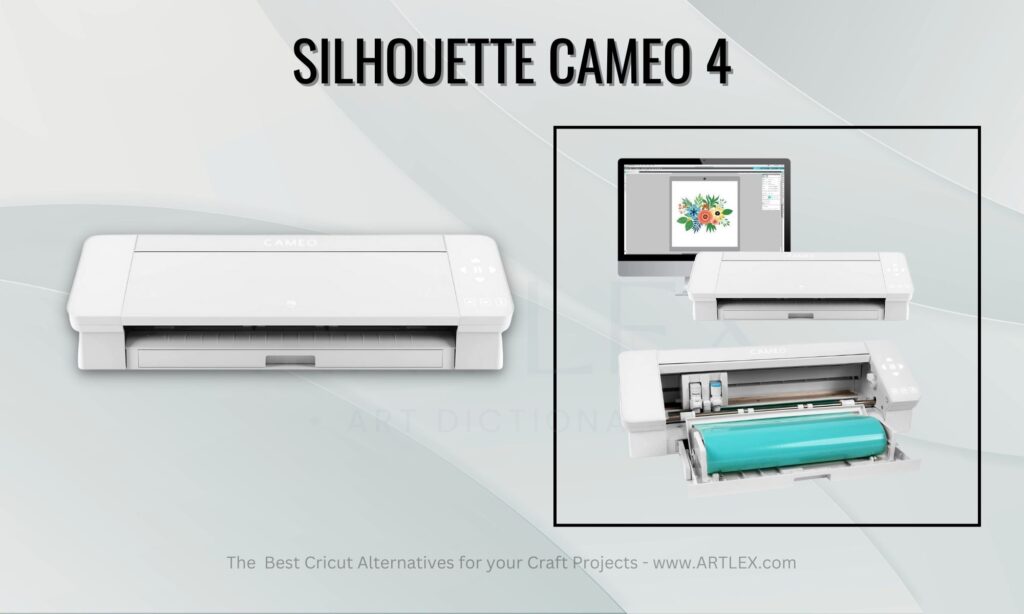
Selection Criteria
- Machine Type: Electronic
- Our Score – 10/10
- Working Area: 12 inches by 24 inches (with mat) and 60 feet (with roll feeder)
- Our Score – 10/10
- Dimensions: 7.87 x 22.44 x 6.69 inches
- Our Score – 10/10
- Compatible Materials and Cutting Force: Fabric, vinyl, cardstock, foam, fabric, chipboard, felt, leather, balsa wood, and more. 5 kgf Cutting Force
- Our Score – 9/10
- Connectivity: USB and Bluetooth® connectivity
- Our Score – 9/10
- Price: $279.99
- Our Score – 9/10
About the Silhouette Cameo 4
While there are not many options on the market, there are two brands that stand out as equal to or better than Cricut. Both brands have their own unique perks, but we ultimately chose the Silhouette Cameo 4 as our top pick.
One of the key features of the Cameo 4 and the reason it made it to the top of our list is the price. Silhouette machines not only have a lower starting price, but they also include the automatic roll feeder that is sold apart in other brands. That also means it can cut materials (with a backing) without the need for a mat and can cut up to 10 ft for those large wall designs that we love so much.
In contrast to the Silhouette Portrait, which is the smaller and more budget version of the Cameo family, the Cameo 4 can cut up to 100 materials including thicker materials like bonded fabric and balsa wood. Although the auto blade feature is not the most precise, it’s a quite useful perk, however further research and understanding of the cutting software is needed.
The Cameo 4 comes with an improved tool carriage, which allows for more precision in cutting and the ability to use a larger range of tools. It also has a dual carriage system, meaning you can load two tools at once and switch between them during a single project.
It also has an enhanced 5 KgF Cutting force, surpassing most cutting machines, Cricut included. It was both wired and wireless connectivity and also has a larger touch interface for easier navigation and control.
The software used by the Cameo 4 is the Silhouette Studio, which is free, but comes with two optional paid updates that make it a very powerful design software.
Pros
- Low price compared to similar machines
- Integrated roller feeder
- Powerful design software
Cons
- Lightweight in comparison to similar machines
- Reported issues with Bluetooth connectivity
- Not beginner-friendly
2. Best Multipurpose Cricut Alternative – Brother ScanNCut 125E
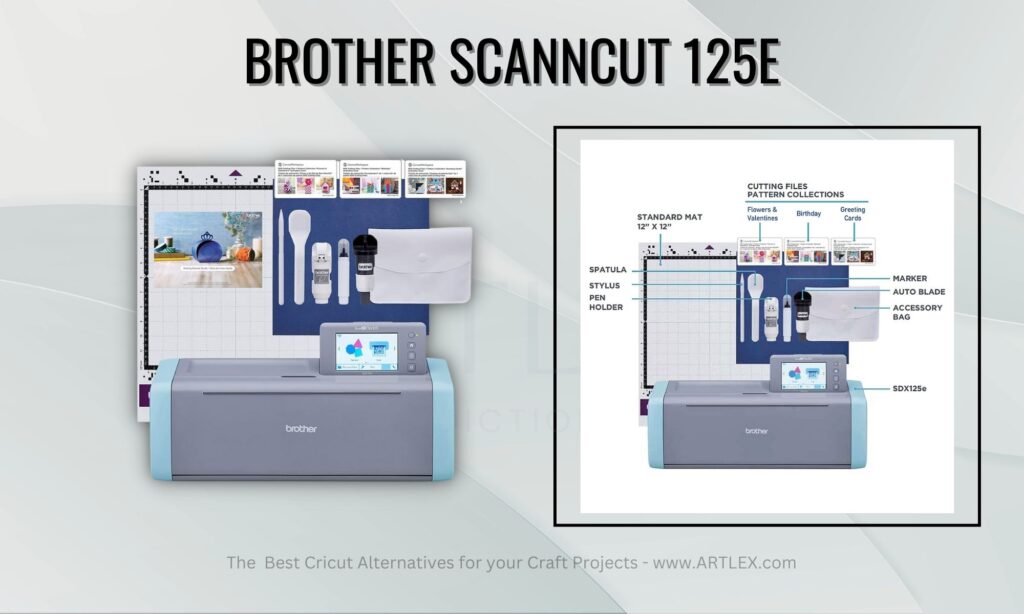
Selection Criteria
- Machine Type: Electronic
- Our Score – 10/10
- Working Area: 12 inches by 24 inches (with mat) and 70 inches (with roll feeder)
- Our Score – 9/10
- Dimensions: 8.4 x 20.9 x 6.8 inches
- Our Score – 10/10
- Compatible Materials and Cutting Force: Fabric, vinyl, cardstock, foam, fabric, chipboard, felt, leather, balsa wood, and more. 5 kgF of Cutting Force
- Our Score – 9/10
- Connectivity: USB and Wi-Fi connectivity
- Our Score – 9/10
- Price: $399.99
- Our Score – 8/10
About the Brother ScanNCut 125E
The Brother ScanNCut is a great alternative to Cricut and in some cases, the best option for certain crafters. This machine is on the same level as the Cameo 4 and the Cricut Maker and Explore, but there is a certain perk that makes it stand out. It has a built-in scanner that allows you to use the machine without the need for a computer, mobile device, cable, etc!
This machine claims to be a “Standalone cutting machine” and it certainly is, the built-in scanner allows you to outline and cut directly, all you need to do is introduce your material, and the machine will scan it, let you set an outline thickness and cut it perfectly in matters of seconds. This feature is especially useful for scrapbookers, quilters, and sticker makers since all you need is the LCD screen to make your projects.
It also has the auto-blade feature, where the blade automatically detects the material thickness and lets you cut without any additional steps, the Canvas Workspace coordinates with your sewing machines (in case you have them) and lets you cut patterns in the fabric that match your sewing and quilting projects.
The only downside would be that this machine is not that well-known in the market, therefore, there are not that many tutorials or courses available and it tends to go out of stock from time to time.
Pros
- It has a built-in scanner for easy cutting
- Doesn’t need a computer to work
- Is very quiet
Cons
- There aren’t many courses or resources available online
- Consumables are pricier than competitors
3. Best Large Format Cricut Alternative – Silhouette Cameo 4 Pro
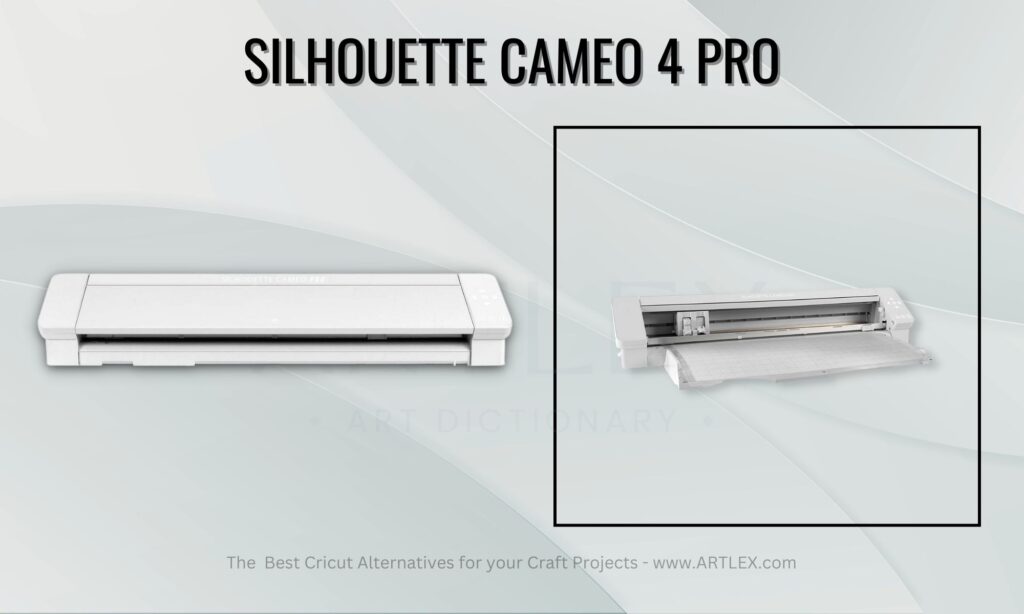
Selection Criteria
- Machine Type: Electronic
- Our Score – 10/10
- Working Area: 24 inches by 24 inches (with mat) and 10 feet (with roll feeder)
- Our Score – 10/10
- Dimensions: 34 x 12 x 10 inches
- Our Score – 10/10
- Compatible Materials and Cutting Force: Fabric, vinyl, cardstock, foam, fabric, chipboard, felt, leather, balsa wood, and more. 5 kgF of Cutting Force
- Our Score – 9/10
- Connectivity: USB and Bluetooth connectivity
- Our Score – 9/10
- Price: $469.99
- Our Score – 8/10
About the Silhouette Cameo 4 Pro
The major difference between the Cameo 4 and the Cameo 4 Pro is definitely the size. While the Cameo can cut up to 12″ wide, the Cameo 4 Pro cuts up to 24″ which is fantastic for small businesses and the previous step before going industrial.
The price point of the Cameo 4 Pro makes it incredibly accessible compared to other professional large-scale cutting machines, and the integrated roll feeder lets you cut up to 10 feet in length. This machine is also compatible with the kraft blade and the rotary blade, which makes it a great option for quilting and leather projects.
Pros
- Large format cutting
- Powerful design software
- Integrated roll feeder and matless cutting
Cons
- Cutting force is wasted since compatible materials only use a fraction of it
- The build is not as resistant as other machines
4. Best Budget Cricut Alternative – Silhouette Cameo Portrait
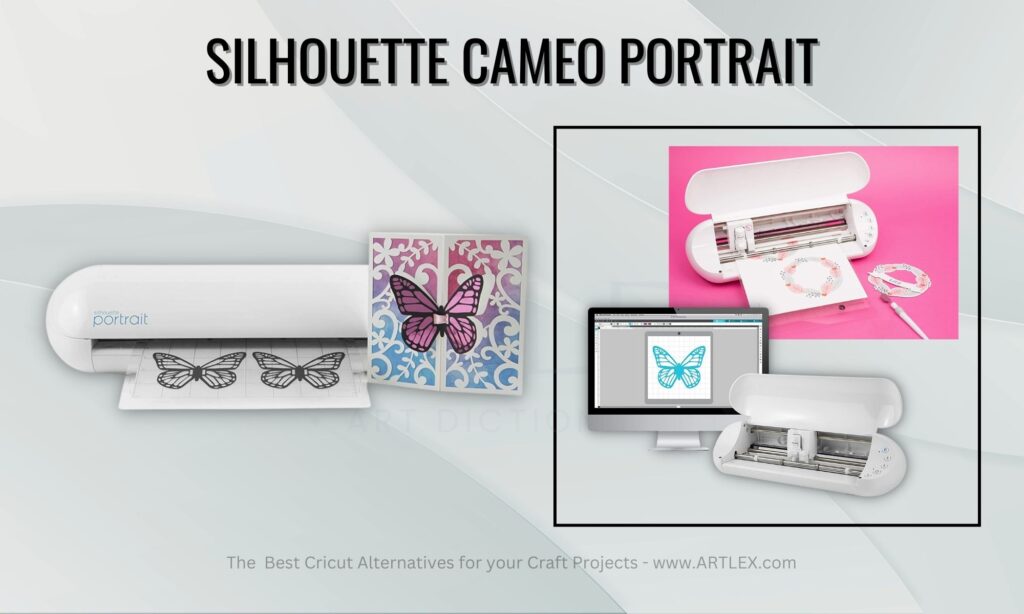
Selection Criteria
- Machine Type: Electronic
- Our Score – 10/10
- Working Area: 24 inches by 24 inches (with mat) and 10 feet (with roll feeder)
- Our Score – 10/10
- Dimensions: 34 x 12 x 10 inches
- Our Score – 10/10
- Compatible Materials and Cutting Force: Fabric, vinyl, cardstock, foam, fabric, and more. 1.25 kgF of Cutting Force
- Our Score – 9/10
- Connectivity: USB and Bluetooth connectivity
- Our Score – 9/10
- Price: $179.99
- Our Score – 9/10
About the Silhouette Cameo Portrait
Many of us are familiar with the small version of Cricut, the Cricut Joy. This machine is not only the smallest but also the less powerful of the Cricut family, however, it’s perfect for those on a budget or that won’t be doing large-scale projects.
The perfect alternative to this machine is the Silhouette Cameo Portrait which is almost twice larger and much more versatile than the Cricut Joy. Some features that we must highlight are tool adaptability, cutting length, and material compatibility. Although the Cameo Portrait is not as powerful as the Cameo 4, it can still cut more materials than the Cricut Joy.
The price is about the same as a Cricut Joy, with a $20 difference which is certainly worth it since this small and portable machine offers many more functions than the small Cricut Joy.
Pros
- Small and portable
- Cuts a lot of materials
- Wireless connectivity
Cons
- Doesn’t cut thicker materials
5. Best Manual Die Cutting Machine – Sizzix Big Shot
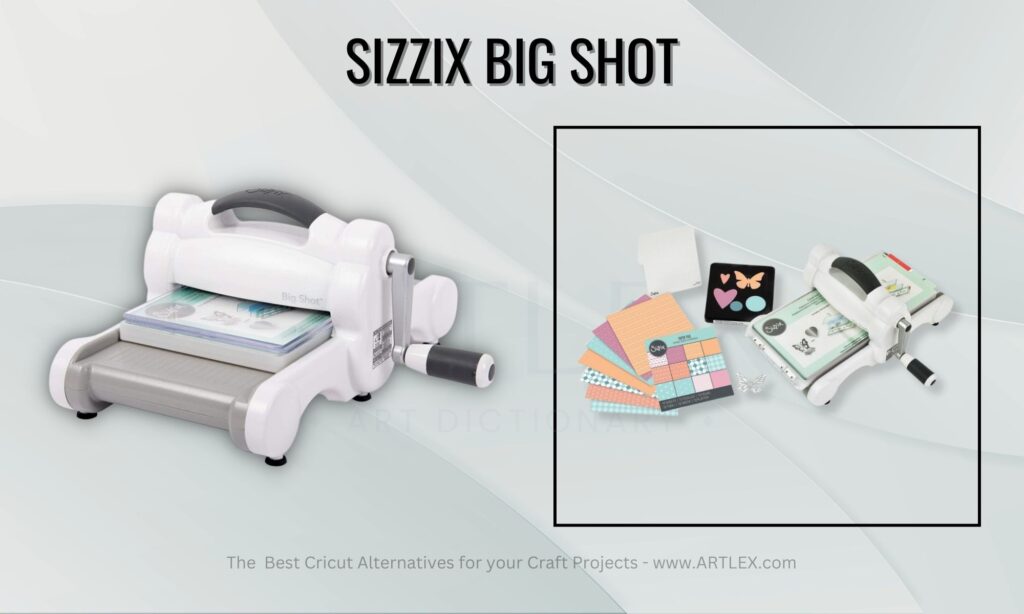
Selection Criteria
- Machine Type: Manual Die Cutting Machine
- Our Score – 9/10
- Working Area: 6 inches by 11 inches
- Our Score – 8/10
- Dimensions: 16.6 x 11.6 x 9.1 inches
- Our Score – 8/10
- Compatible Materials: Fabric, vinyl, cardstock, foam, fabric.
- Our Score – 9/10
- Price: $95.99
- Our Score – 9/10
About the Sizzix Big Shot
Die Cut machines have been in the market for the longest time, and have only gotten better and easier to use with the year. One of the most popular and high-quality brands is Sizzix.
This die-cut machine offers a great alternative to electronic cutting machines like Cricut and Silhouette, although not as versatile and designed for scrapbooking, card making, and home decor, it can cut through a wide variety of materials including cardstock, fabric, felt, and foam.
The major advantage of the Sizzix Big Shot is the larger working area, the portability, and the fact that you don’t need electricity or a computer or mobile device to use it. It’s very easy to use and it doesn’t have that much of a learning curve.
It’s also very affordable and durable, although you might want to consider the added costs of material and dies.
Pros
- Larger and more powerful than other machines
- Lots of dies available
Cons
- Limited designs
- Doesn’t cut thicker materials
6. Best Die Cutting Machine for Quilting – AccuQuilt GO!
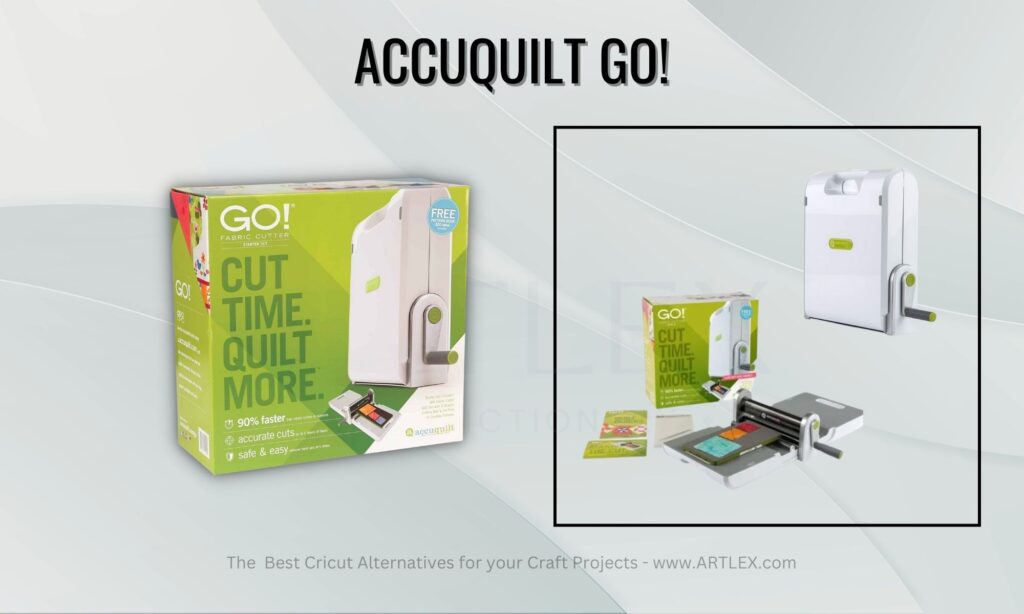
Selection Criteria
- Machine Type: Electric Die Cutting Machine
- Our Score – 10/10
- Working Area: 10 inches by 24 inches max
- Our Score – 10/10
- Dimensions: 17 x 5 x 15 inches
- Our Score – 10/10
- Compatible Materials: Fabric.
- Our Score – 9/10
- Price: $329.99
- Our Score – 8/10
About the AccuQuilt GO!
Cutting machines are one of the go-to tools for sewers and quilters, however as they are not designed specifically for quilters, there are certain limitations that come with it.
The AccuQuilt GO! is a great alternative to the Cricut for those who work primarily with fabric. The AccuQuilt GO! uses special dies to cut the fabric into various shapes, including squares, triangles, circles, and more.
Since it doesn’t need a program or a computer to work, it’s much easier to use, and since it can cut multiple layers at a time with amazing precision, boosting productivity and making quilting much easier.
Another benefit of AccuQuilt GO! is its ease of use. The machine is very intuitive, and it doesn’t require any tech knowledge or design skills to operate. Simply choose the die that corresponds to the shape you want to cut, place your fabric on top of it, and run it through the machine.
The price is about the same as a cricut explore, however on the expensive side of die-cutting machines, however since this one works with electricity to process the cuts, it’s much faster, easier, and more accurate than manual ones.
Pros
- Portable and easy to transport
- Easy to use and very powerful
- Cuts several layers at a time
Cons
- Needs electricity to work
- Might be too small for some projects
Conclusions
Finding the best cutting machine is directly tied to the specific purpose you want to give it. If you are just beginning your crafting journey, then starting small is the best choice. Crafting is not for everybody, so getting a machine that you can use for everyday things that doesn’t requires that much of an investment is probably the best way to start.
If you’re already a seasoned crafter, then you probably have a niche or a favorite material. If you’re looking for a replacement for your Cricut or for an upgrade then going big might be what you need. The Cameo 4 offers all the benefits of a personal cutting machine along with the perks of large-format production.
Finding the machine that best suits your need is an important part of the process. sometimes, the solution doesn’t lie within cutting machines but with more advanced products like laser cutting machines, specialized vinyl cutting machines, or 3D printers.
If you’re a quilter or a sewer and don’t want to spend too much going from your computer to your machine and back, then I recommend you go for a Die-Cutting machine, or for the Brother ScanNCut, which was made with quilters and sewers in mind.
Cutting Machines FAQ
Q: What is a Cricut cutting machine?
A: A Cricut cutting machine is a popular personal cutting machine that allows users to cut intricate designs out of a wide range of materials such as paper, vinyl, fabric, and more.
Q: Why would someone look for a Cricut alternative?
A: There are several reasons why someone might be interested in a Cricut alternative. One reason could be the cost – Cricut machines can be quite expensive. Another reason might be the desire for a different set of features or capabilities that a Cricut machine doesn’t offer.
Q: What are some alternatives to a Cricut cutting machine?
A: Some popular alternatives to a Cricut cutting machine include the Silhouette Cameo 4, Brother ScanNCut 125E, and Sisser Juliet.
Q: How does the Silhouette Cameo 4 compare to a Cricut machine?
A: The Silhouette Cameo 4 is a popular alternative to a Cricut machine that offers several unique features such as a dual carriage system and compatibility with a wider range of materials.
Q: What sets the Brother ScanNCut 125E apart from other cutting machines?
A: The Brother ScanNCut 125E is unique in that it offers a built-in scanner that allows users to cut directly from the material. It also comes with a large LCD touchscreen display and wireless connectivity options.
Q: Can I use materials other than paper and vinyl with these alternative cutting machines?
A: Yes, all of the alternatives mentioned above are compatible with a wide range of materials beyond just paper and vinyl, including fabrics, leather, and more. However, it’s important to check the specific capabilities and compatibility of each machine before using them.
Q: Do the alternatives have a similar software to the Cricut Design Space?
A: The Silhouette Studio software that comes with the Silhouette Cameo 4 is similar to Cricut Design Space and allows for designing and cutting with the machine. The Brother ScanNCut 125e comes with its own software called ScanNCutCanvas, which also allows for designing and cutting with the machine.
Q: Can the alternatives be used for both personal and commercial projects?
A: Yes, all three machines can be used for personal and commercial projects. However, it’s important to check for any specific regulations or limitations on commercial use with each individual machine.



